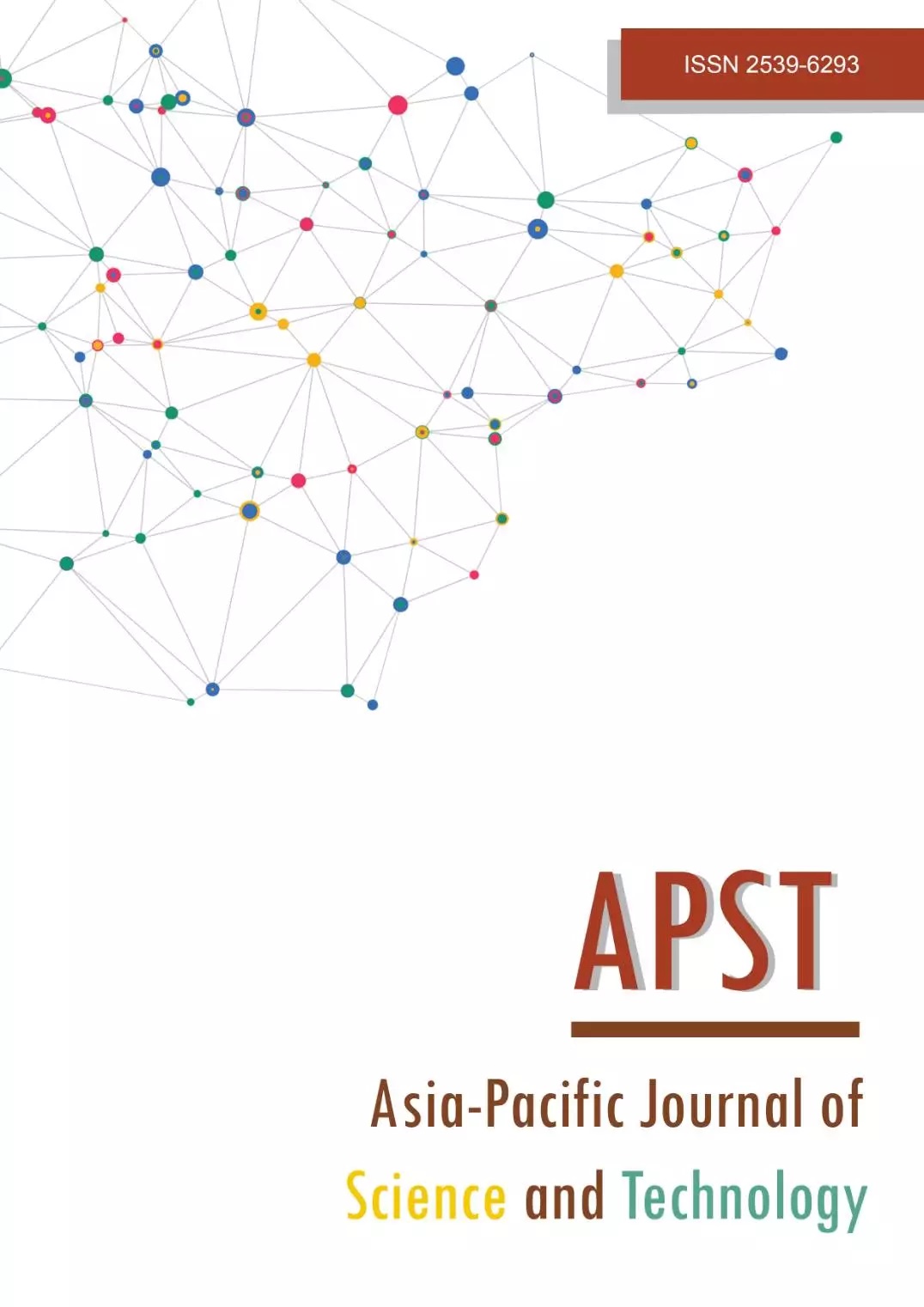BPSL1665 does not play a role in ceftazidime resistance during biofilm growth of Burkholderia pseudomallei
Main Article Content
Abstract
Burkholderia pseudomallei is a Gram-negative bacterium that causes melioidosis, a serious infectious disease affecting both human and animals. Ceftazidime (CAZ) is a drug of choice. However, the bacterium in biofilm form becomes resistant to CAZ with mechanisms remain unclear. B. pseudomallei BPSL1665 is orthologue with PA1877, an efflux pump gene in Pseudomonas aeruginosa that participated in biofilm-related antibiotics resistance. BPSL1665 expressed higher in biofilm form, and a universal efflux pump inhibitor, phenylalanine arginine β-napthylamide (PAβN), could increase the CAZ sensitivity of the bacterium. B. pseudomallei BPSL1665 mutant therefore was constructed and tested for CAZ and Ciprofloxacin (CIP) susceptibility. The minimal inhibitory concentration (MIC) of wild type and the mutant of planktonic against CAZ and CIP were 4 and 2 mg/mL. The Minimum Biofilm Inhibitory Concentration (MBIC) and the Minimum Biofilm Eradication Concentration (MBEC) against CAZ of wild type and the mutant were 32 and >1024 mg/mL. The MBIC and MBEC against CIP of the wild type and the mutant were 16 and 512, and 8 and 512 mg/mL. When 50 mg/mL of PAβN was combined with each antibiotic, the titer of MBIC was reduced to 2 mg/mL, however, the MBEC against CAZ did not change. For CIP, the MBIC and the MBEC were not changed. Nevertheless, the BPSL1665 mutant showed all responses similar to its wild type. Recently, BPSL1665 has been annotated as type I secretion membrane fusion, HlyD family protein. PAβN may influence other efflux pumps that further study may help improve the B. pseudomallei biofilm treatment.
Article Details

This work is licensed under a Creative Commons Attribution-NonCommercial-NoDerivatives 4.0 International License.
References
Whitmore A. An account of a glanders-like disease occurring in Rangoon. J Hyg (London). 1913;13(1):1-34.1.
Birnie E, Biemond JJ, Wiersinga WJ Drivers of melioidosis endemicity: epidemiological transition, zoonosis, and climate change. Curr Opin Infect Dis. 2022;35(3):196-204.
Wiersinga WJ, Currie BJ, Peacock SJ. Melioidosis. New Engl J of Med. 2012;367(11):1035-1044.
Wiersinga WJ, Virk HS, Torres AG, Currie BJ, Peacock SJ, Dance DAB, et al. Melioidosis. Nat Rev Dis Primers. 2018;4:17107.
Limmathurotsakul D, Paeyao A, Wongratanacheewin S, Saiprom N, Takpho N, Thaipadungpanit J, et al. Role of Burkholderia pseudomallei biofilm formation and lipopolysaccharide in relapse of melioidosis. Clin Microb Infect. 2014;20(11):O854-O856.
O'Toole G, Kaplan HB, Kolter R. Biofilm formation as microbial development. Annual Rev Microb. 2000;54(1):49-79.
Hoyle BD, Costerton WJ. Bacterial resistance to antibiotics: the role of biofilms. Prog Drug Res. 1991;37:91-105.
Rholl DA, Wallace PKM, Tomaras AP, Vasil ML, Bonomo RA, Schweizer HP. Molecular investigations of PenA-mediated β-lactam resistance in Burkholderia pseudomallei. Front Microbiol. 2011;2:139.
Chan YY, Tan TM, Ong YM, Chua KL. BpeAB-OprB, a multidrug efflux pump in Burkholderia pseudomallei. Antimicrob Agents Chemother. 2004;48(4):1128-1135.
Podnecky NL, Rhodes KA, Schweizer HP. Efflux pump-mediated drug resistance in Burkholderia. Front Microbiol. 2015;6:305.
Zhang L, Mah TF. Involvement of a novel efflux system in biofilm-specific resistance to antibiotics. J Bacteriol. 2008;190(13):4447-4452.
Yabuuchi E, Kosako Y, Oyaizu H, Yano I, Hotta H, Hashimoto Y, et al. Proposal of Burkholderia gen. nov. and transfer of seven species of the Genus Pseudomonas homology group II to the new genus, with the type species Burkholderia cepacia (Palleroni and Holmes 1981) comb. nov. Microbiol Immunol. 1992;36(12):1251-1275.
Sirijant N, Sermswan RW, Wongratanacheewin S. Burkholderia pseudomallei resistance to antibiotics in biofilm-induced conditions is related to efflux pumps. J Med Microbiol. 2016;65(11):1296-1306.
Holden MT, Titball RW, Peacock SJ, Tárraga CAM, Atkins T, Crossman LC, et al. Genomic plasticity of the causative agent of melioidosis, Burkholderia pseudomallei. Proc Natl Acad Sci U S A. 2004; 101(39):14240-14245.
López CM, Rholl DA, Trunck LA, Schweizer HP. Versatile dual-technology system for markerless allele replacement in Burkholderia pseudomallei. Appl Environ Microbiol. 2009;75(20):6496-503.
Choi KH, Mima T, Casart Y, Rholl D, Kumar A, Beacham IR, et al. Genetic tools for select-agent-compliant manipulation of Burkholderia pseudomallei. Appl Environ Microbiol. 2008;74(4):1064-1075.
Reller LB, Weinstein M, Jorgensen JH, Ferraro MJ. Antimicrobial susceptibility testing: a review of general principles and contemporary practices. Clin Infect Dis. 2009;49(11):1749-1755.
Sawasdidoln C, Taweechaisupapong S, Sermswan RW, Tattawasart U, Tungpradabkul S, Wongratanacheewin S. Growing Burkholderia pseudomallei in biofilm stimulating conditions significantly induces antimicrobial resistance. PLoS One. 2010;5(2):e9196.
Renau TE, Léger R, Flamme EM, Sangalang J, She MW, Yen R, et al. Inhibitors of efflux pumps in Pseudomonas aeruginosa potentiate the activity of the fluoroquinolone antibacterial levofloxacin. J Med Chem. 1999;42(24):4928-4931.
Kumar A, Mayo M, Trunck LA, Cheng AC, Currie BJ, Schweizer HP. Expression of resistance-nodulation-cell-division efflux pumps in commonly used Burkholderia pseudomallei strains and clinical isolates from northern Australia. Trans R Soc Trop Med Hyg. 2008;102 Suppl 1:145-151.
Ross BN, Myers JN, Muruato LA, Tapia D, Torres AG. Evaluating new compounds to treat Burkholderia pseudomallei infections. Front Cell Infect Microbiol. 2018;8:210.
Biot FV, Lopez MM, Poyot T, Ripoll NF, Lignon S, Caclard A, et al. Interplay between three RND efflux pumps in doxycycline-selected strains of Burkholderia thailandensis. PLoS One. 2013;8(12):e84068.
Schweizer HP. Mechanisms of antibiotic resistance in Burkholderia pseudomallei: implications for treatment of melioidosis. Future Microbiol. 2012;7(12):1389-1399.
Dinh T, Paulsen IT, Saier MH. A family of extracytoplasmic proteins that allow transport of large molecules across the outer membranes of gram-negative bacteria. J Bacteriol. 1994;176(13):3825-3831.
Poole K. Multidrug efflux pumps and antimicrobial resistance in Pseudomonas aeruginosa and related organisms. J Mol Microbiol Biotech. 2001;3(2):255-264.
Poole K, Krebes K, McNally C, Neshat S. Multiple antibiotic resistance in Pseudomonas aeruginosa: evidence for involvement of an efflux operon. J Bacteriol. 1993;175(22):7363-7372.
Trunck LA, Propst KL, Wuthiekanun V, Tuanyok A, Sternberg BSM, Sternberg BJS, et al. Molecular basis of rare aminoglycoside susceptibility and pathogenesis of Burkholderia pseudomallei clinical isolates from Thailand. PLoS Negl Trop Dis. 2009;3(9):e519.


